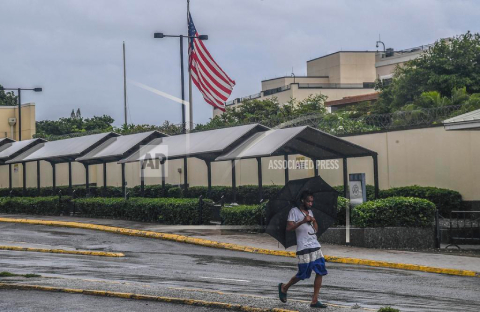SAN JUAN, Puerto Rico (AP) — Hurricane Rafael swirled past the Cayman Islands and was expected to rapidly intensify before making landfall on Wednesday in western Cuba, where it’s forecast to hit as a Category 2 hurricane.
It was another stroke of bad news for Cuba, which has been struggling with blackouts while recovering from another hurricane two weeks ago that killed at least six people in the eastern part of the island.
The storm was located about 120 miles (190 kilometers) southeast of the Isle of Youth, and around 195 miles (310 kilometers) south-southeast of Havana. It had maximum sustained winds of 90 mph (150 kph) and was moving northwest at 14 mph (22 kph), according to the National Hurricane Center in Miami.
Forecasters warned that Rafael was expected to slam into Cuba on Wednesday after dumping rain on Jamaica and the Cayman Islands on Tuesday. The center warned of floods, storm surges and mudslides.
The U.S. State Department issued an advisory for Cuba on Tuesday afternoon, offering departure flights to non-essential staff and American citizens, and advising others to “reconsider travel to Cuba due to the potential impact of Tropical Storm Rafael.”
On Tuesday morning, the Cuban Civil Defense called on Cubans to prepare as soon as possible, because when the storm makes landfall “it’s important to stay where you are.” The day before, authorities said they had issued an evacuation order for 37,000 people in far eastern Cuba, in the province of Guantanamo, due to bad weather.
A hurricane warning was in effect Tuesday for the Cayman Islands and the Cuban provinces of Pinar del Rio, Artemisa, La Habana, Mayabeque, Matanzas and the Isle of Youth.
A tropical storm warning was in effect for the Cuban provinces of Villa Clara, Cienfuegos, Sancti Spiritus and Ciego de Avila, as well as the lower and middle Florida Keys from Key West to west of the Channel 5 Bridge, and Dry Tortugas. The warning was lifted in Jamaica after the storm passed by the western coast. A tropical storm watch was in effect for the Cuban provinces of Camaguey and Las Tunas.
Rafael on Tuesday knocked out power in Jamaica and unleashed flooding and landslides.
The Jamaica Public Service, the island’s electricity provider, said in a statement late Tuesday that impassable roads were preventing crews from restoring power in some areas.
Meanwhile, crews in Little Cayman and Cayman Brac were expected to fan out early Wednesday to assess damage after a direct hit late Tuesday.
Power outages were reported across the Cayman Islands, and schools remained closed on Wednesday.
“While conditions have improved on Grand Cayman, residents are advised to exercise extreme caution on the roads and near coastlines as rough seas and residual flooding risks may persist,” the government said in a statement.
Forecasters warned Rafael would unleash heavy rains across the western Caribbean that could lead to flooding and mudslides in parts of Cuba and the Cayman Islands.
Heavy rainfall also was expected to spread north into Florida and nearby areas of the southeast U.S. during the middle to late part of the week. The Hurricane Center predicted storm surges in Florida could reach 1 to 3 feet in Dry Tortugas and 1 to 2 feet in the Lower Florida Keys. A few tornadoes also were expected Wednesday over the Keys and southwestern Florida.
Rafael is the 17th named storm of the season.
The National Oceanic and Atmospheric Administration predicted the 2024 hurricane season was likely to be well above average, with between 17 and 25 named storms. The forecast called for as many as 13 hurricanes and four major hurricanes.
An average Atlantic hurricane season produces 14 named storms, seven of them hurricanes and three major hurricanes.




